IndiaWilds Newsletter Vol. 13 Issue XII
ISSN 2394 – 6946
Loss of Life due to Climate Change
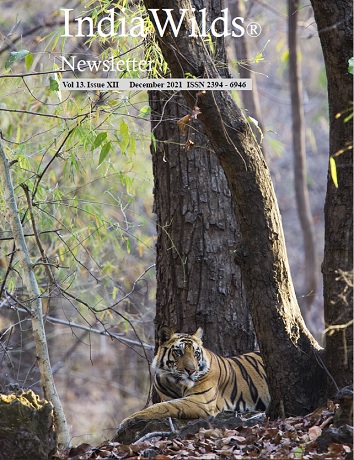
IndiaWilds Newsletter PDF-December-2021
Climate Change has already started showing its deadly fangs to people throughout the world. In India, the impact of Climate Change is seen through frequent cyclonic storms from both sides of India’s coastline. India these days is facing storms in summer season which was earlier never heard off. There are frequent landslides in the hills. Severe unseasonal rains are suddenly inundating cities causing huge loss of property as well as life. Heat waves have become more severe causing deaths of people throughout India. Glaciers in the Himalayas are melting and causing huge challenges to the traditional lifestyles of people. The sea level is increasing due to huge amounts of ice is breaking off from the Artic and Antarctic glaciers. Many islands as well as the entire coastline of India is facing erosion and coastal communities are facing the brunt. It is now well known that we are facing a full blown Climate Crisis and the impact is going to be more severe in future.
Unfortunately, since Climate Change is impacting us in so many different ways as there is a complex ecological relationship binding different natural phenomena, our current science and scientists are hard pressed to clearly and easily understand it. This point was supported by an answer given in Rajya Sabha on 16th December, 2021 by the Minister of State, Ministry of Environment, Forest & Climate Change.
He said that there is no established study for India providing a quantified attribution of climate change to the triggering of natural disasters leading to loss of life and property. While many studies monitor impact of disasters such as floods, drought and heat, the science of attribution of these changes particularly to climate change is far more complex and currently an evolving subject. Most studies so far have relied on mathematical modelling of climate change impacts but these are yet to be empirically verified.
The extant legal and promotional measures cater to the concerns of disasters related to climate change, which are subject to refinement, improvement and further development by the relevant Ministries/Departments at the Centre and the States. The relief, recovery, and rehabilitation related to disasters in India are governed inter alia by the relevant provisions of the Disaster Management Act, 2005 and the guidelines, directives, and orders of the National Disaster Management Authority (NDMA) and the State Disaster Management Authorities. Furthermore, the India Meteorological Department (IMD) is responsible for monitoring, detection and forecasting of weather and climate including early warning for severe weather events such as cyclones, heavy rainfall, extreme temperature, thunderstorms, and other such extreme events.
The National Disaster Management Authority (NDMA) and State Disaster Management Authority (SDMA) spearhead and implement holistic and integrated approach to Disaster Management in India. NDMA has issued guidelines for the preparation of District Disaster Management Plans (DDMPs). In addition, the National Disaster Management Plan prepared by NDMA in 2019 and the respective State Disaster Management Plans provide the overall framework and guidance for the preparation of DDMP. Further, the relief, recovery, and rehabilitation related to disasters in India are governed inter alia by the relevant provisions of the Disaster Management Act, 2005 and the guidelines, directives, and orders of the NDMA and the SDMAs.
As part of India’s participation and leading international cooperation and collaboration in these matters, the Coalition for Disaster Resilient Infrastructure (CDRI) has been launched in 2019 and headquartered in India. It aims to promote the resilience of new and existing infrastructure systems to climate and disaster risks through updating and enhancing information on the exposure of infrastructure systems, and model climate related hazards such as droughts and heat waves, enabling near time response.
Common men and women of this country will immediately not place much emphasis on the answer of the Minister regarding no studies in India to pin point impact of climate change. Unfortunately, India with its nearly 1.4 billion people has started facing the brunt of climate change and in future that is going to be very severe. And only then people will realise the real meaning of this statement.
With rise in global sealevels, the coastal communities will be worst affected. Already many fishing communities are forced to abandon their villages as the shoreline is changing for the worse. To protect the shoreline of the cities, rocks are poured on to the water to create walls. This diverts the currents to few kilometers away and that hits the fishing villages. With sealevel rise due to Climate Change many of the coastal communities who are among the most poor and marginal are going to have their houses drowned. As such fishermen are being squeezed out because the price of land has gone through the roof. In many places lavish residential colonies and industries have taken over most of the land. So the poor fishermen have to leave their traditional fishing areas and migrate to other places. There have been many instances of hundreds of fishing folks migrating from Andhra Pradesh to Odisha.
Most of the coastal communities will be further pushed into poverty. Earlier the women folk used to collect firewood, roots, tuber, fruits etc. These days due to lack of village grazing lands and other community plantation areas, the coastal communities can’t depend on their daily firewood and other fruits etc for their kitchen. The fishermen in the sea area also facing dwindling catch due to death of corals because of higher temperatures and acidification of the ocean.
Sudden cyclones and seawater ingress causing loss of life and drowning settlements is another big challenge. It is easy to predict that India is going to see millions of Climate refugees moving from one part of the country to another.
What kind of quality of life are we giving our own citizens? Our big cities are already under massive stress as concentration of jobs is leading to overcrowding, resulting in crumbling infrastructure. Even huge dams are not able to meet the water needs of big cities. The air pollution has become so high that millions of people have started falling prey to asthma, bronchitis, cancer and other such diseases. When the Climate Refugees start heading towards the big cities enmasse, the situation would become disastrous.
Already there are reports from Sundarbans that after the recent cyclones, the poor women folk are falling prey to the flesh trade. Hunger often trumps over morals.
No amount of speeches glorifying the valour of Indian soldiers can rouse the morale of men and women sleeping for days together in hungry stomach. History has taught us that “A Hungry Man is an Angry Man”. Psychologists often say that even the most hardened criminals cook up a story to justify their own acts so that their conscience doesn’t hurt them. Some poor folks can easily get trapped by people who are engaged in actions that are inimical to India’s interests. As such, these days even the middle class and the rich are devoid of ethics. The difference between the Hero and Villain has blurred. People who have become rich by any means are now touted as Heroes and Heroines. In these times when the social mores have changed, the poor and marginal communities becoming the greatest victims of Climate Crisis would cause huge stress to the social fabric apart from the economy. It can lead to social strife. So, we as a Nation should be very worried.
Save the Elephants of Odisha
We human beings have never known to choose our living place wisely. We necer give a good thought before deciding on where to live. We start staying at a place and then after some time decide that it is not suitable for our needs and then we move to another place. This is characteristic is perhaps exemplified by the Delhi to Daulatabad shifting of capital by Sultan Muhammad Bin Tughlaq. Many people died while shifting of the capital. Later he again decided to move back the capital to Delhi.
Elephants need huge amount of food and hence need to keep on moving from one area to other while feeding. Their stomach is designed in such a way that the digestion efficiency is less and hence lot of seeds come out through the gut being partially digested and easily germinates with the dung. In this manner, various plant species have evolved and have propagated.
In stark contrast to human beings, elephants understand which place is suitable for them.
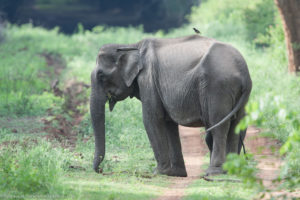
Elephant feeding grass in exotic infested landscape
Depending on the season elephants know where to travel for their food needs. This age-old knowledge is passed down from generation to generation. Unfortunately, we humans are rapidly changing the landscape by constructing dams, roads, canals, mines, towns and cities etc. The existing fruit and flowering trees, plants and creepers are vanishing, as a result the elephants have to search for food in other areas and hence have to change their seasonal age-old migratory path. Hence, more and more the elephants are found in areas where they have not been found in the last 50-60 years. As a result, conflict is inevitable.
Elephant Killing Fields
In Odisha, between 2016-17 and 2020-21 a total of 406 elephants have died due to various causes. Since the financial year 2016-17, on an average 80 elephants died every year in odisha. 162 elephants have died due to accidents. 54 were electrocuted. Fourteen elephants were run over and killed by trains. Poaching led to a further 11 elephant deaths. Normally poachers kill tuskers in their prime for their tusks. That single action leads to loss of valuable genetic pool as with fewer wild tuskers, the female elephants have to mate with the other available males. In the wild the female elephants allow only the fittest male elephants to mate with them. So even though poaching numbers appear less, it creates a disproportionate impact on the genetic diversity.
Between 2018-19 and till May end 2021, roughly one elephant was killed in odisha every five days.
In the FY 2018-19 a total of 93 elephants died. 82 elephants died in 2019-20 and this year till august 30 elephants have died. 95 elephants died due to diseases. Though this data was given by the Odisha forest minister in the Odisha assembly, not much effort is visible from the Government to stop this elephant killing in Odisha. To make matters worse, conservationists estimate that the elephant death numbers provided by the Odisha Government is much lower than the actual number of deaths. Often, the local forest officials prefer to not report the deaths as they fear being accused of incompetency.
The fast-moving trailers moving out from the mines in Odisha often mow down elephants. Culturally elephants are revered in eastern India in Odisha, Assam and West Bengal. When an elephant dies, people place flowers over it, light incense sticks and pay obeisance. However, these common men and women in most of the cases don’t have any say in the elephant killings.
The roads constructed to ferry ore from the mines to the ports cut through elephant migratory corridors. The roads are poorly designed. There are no underpasses for elephants to use it. Constructing underpasses and elevated roads increases the cost of the road building and the NHAI (National Highway Authority of India) officers fight tooth and nail against it. In the past the central minister has often bulldozed the forest and environment minister and got away without constructing adequate mitigation measures. These people are driven by money and don’t care for Elephant, our National Heritage animal.
In Odisha in the past the state distribution utility companies were earlier owned by a Reliance entity. They were loath to do maintenance of power lines. Several times elephants died due to low hanging wires. In some cases, people while trying to steal electricity leave live wires and elephants have been electrocuted. 54 elephants electrocuted in the last five years indicate how bad the situation is in Odisha. No person has been prosecuted for elephant electrocution. Hence, one can safely assume that elephants will continue to be electrocuted in Odisha.
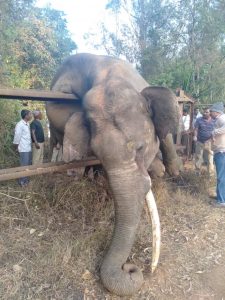
Elephant on fence
In India, much of elephant habitat falls outside protected areas. The Government as well as the State Governments have never taken a holistic landscape level view of conserving wildlife. To save our elephants, we need to immediately stop the elephant deaths. Immediately take steps to save the elephant corridors. The government has to buy up land in the existing elephant corridors so as to ensure that elephants can travel uninterrupted without getting hit by vehicles, trains, live wires. By ensuring undisturbed migratory corridors, the man-elephant conflict will also be reduced. The payment that Government makes towards compensation for crop and house damage as well as towards loss of life can be averted.
To allow loss of human as well as elephant life to continue due to lack of planning is not only irresponsible but also immoral. We the civil society can always step up to help the Government in raising resources for recreating and augmenting the elephant corridors. What is needed is the willpower to be shown by the Government. Unfortunately, in this era of non-stop politicking, the Government and Government officers perhaps have different priorities. If we don’t act now, it would be too late to turn back the clock. Hope better sense prevails.
Article:
Journey to Leopard country
Conservation News:
Career in Environment and Wildlife Conservation
20th December, 2021
The Ministry of Environment, Forest & Climate Change (MoEF&CC) is implementing the Environment Education, Awareness and Training (EEAT) Scheme with the objective to promote environmental awareness especially among school and college students and to mobilize their participation for conservation of environment. Under the National Green Corps (NGC) programme of this Scheme, more than one lakh Eco-clubs have been formed in schools and colleges to educate students and to spread awareness on environmental issues. MoEF&CC also supports organization of field visits/ nature camps for school students in Protected Areas, Wildlife Sanctuaries, National Parks, etc. under the National Nature Camping Programme of EEAT Scheme with an objective to provide ‘nature experience’ to students and thereby to trigger their sensitivity towards nature and its conservation. As per information provided by Department of Youth Affairs, awareness on environment conservation and enrichment is a component in the regular activities of National Service Scheme (NSS). Volunteers of NSS organize activities on environment conservation, climate change, use of renewable energy and other related issues in addition to plantation drives.
On a pilot basis MoEF&CC had launched the Green Skill Development Programme (GSDP) in June 2017 under the ongoing Environmental Information System (ENVIS) Scheme, at 10 locations, spread over 9 biogeographic regions of the country. The objective of GSDP was to skill youth in environment, forest and wildlife sectors and enable them to be gainfully employed or self-employed. Based on the success of the pilot phase, the programme was extended to pan-India level in 2018-19 covering diverse fields like pollution monitoring (air/water/soil), emission inventory, operation of Sewage Treatment Plant(STP)/ Effluent Treatment Plant (ETP)/ Common Effluent Treatment Plant(CETP), waste management, environmental impact assessment, forest management, water budgeting and auditing, wildlife management, para taxonomy including Peoples Bio-Diversity Register(PBR), bamboo management and livelihood generation, etc. The training imparted under GSDP endeavours to enhance technical knowledge of the skilled workforce with a focus on hands-on training.The ENVIS Hubs/ Resource Partners and other institutions imparting training under the GSDP invite applications from all over the country and the placements take place based on employment opportunities available within or outside the State / Union Territory.
India Surface Temperature increased by 0.7°C during 1901–2018
17th December, 2021
The Government has been assessing climate change over the years through various Ministries and Agencies. The India Meteorological Department (IMD) brings out the publication ‘Annual Climate Summary’ at the end of every year that features highlights of climate patterns and long-term changes since the year 1901 in all-India temperature and rainfall at annual and seasonal scales. Climate change is a global collective action problem. As per the Intergovernmental Panel on Climate Change (IPCC) The Working Group I contribution to the Sixth Assessment Report titled, “Climate Change 2021: The Physical Science Basis”, global warming of approximately 1.07°C has already occurred in the decade 2010-2019 since 1850-1900. According to the Ministry of Earth Sciences, the surface air temperature over India has risen by about 0.7°C during 1901–2018.
Reports from various sources including IPCC highlight that the challenges faced due to global warming are mainly due to cumulative historical and current greenhouse gas emissions of the developed countries. India with more than 17 % of global population has contributed only about 4 % of the global cumulative greenhouse gas emissions between 1850 and 2017……………
For more details check the link below:
Implementation of Green India Mission
16th December, 2021
The Ministry of Environment, Forest and Climate Change supports the States/Union Territories for carrying out afforestation activities through Centrally Sponsored Scheme namely National Mission for a Green India (GIM). It’s stated aim is to protect, restore and enhance India’s forest cover and to respond to climate change. Also, afforestation is being carried out by the States/Union Territories under various schemes of Central Government and State Government. As per report compiled in the Ministry under twenty point programme, afforestation is being taken up annually over 2.0 million ha since 2019-20. Details of fund released and fund utilisation under Green India Mission are as below.
Rs. in Crore
| Sr. No. | State | Fund Released | Fund Utilized |
| 1 | Andhra Pradesh | 4.17 | 4.17 |
| 2 | Chhattisgarh | 66.63 | 66.27 |
| 3 | Himachal Pradesh | 17.09 | – |
| 4 | Jammu & Kashmir | 25.73 | – |
| 5 | Karnataka | 8.97 | 8.97 |
| 6 | Kerala | 25.47 | 9.88 |
| 7 | Manipur | 38.37 | 38.37 |
| 8 | Mizoram | 72.95 | 72.95 |
| 9 | Odisha | 49.57 | 42.06 |
| 10 | Punjab | 15.52 | 14.85 |
| 11 | Uttarakhand | 48.10 | 48.10 |
| 12 | Madhya Pradesh | 54.81 | 54.81 |
| 13 | Maharashtra | 10.30 | 7.65 |
| 14 | Sikkim | 8.64 | 8.64 |
| 15 | West Bengal | 9.43 | – |
| Total | 455.75 | 376.72 |
The State Forest Departments are supposed to take up afforestation activities considering weather and soil condition. It is important to plant trees that are native to each region as exotic species cause huge loss of biodiversity, has impact on wildlife as well as economic impact on people. The National Mission for a Green India also encourages the plantation of mixed indigenous species along with grasses, herbs, shrubs and tree species. MoEF&CC has also sent advisories to State and Union Territories asking them to stick to locally suitable tree species for afforestation programs. Unfortunately, such blanket statements doesn’t help as people on the ground need list of species that can be planted. Without such lists people tend to plant only 4-5 species of trees they are aware of.
Closure of Industries not running on Gas in NCR
Air Quality Commission orders immediate closure of NCR industries not running on gas/ Cleaner fuels in industrial areas despite availability of gas infrastructure and supply
14th December, 2021
Despite the measures taken in different sectors towards improvement of air quality of Delhi-NCR, the air quality still remains in ‘Very Poor’ to ‘Severe’ category. Keeping in view the need to enforce strict actions against the deteriorating air quality of the region, the Commission for Air Quality Management in NCR and Adjoining Areas (CAQM) believes that there is an urgent need to take further preventive measures, as a matter of extreme emergency and abundant caution….. For more check the link:
Solar Capacity increased 18 times between March 2014 to October 2021
6th December
As a Party to the United Nations Framework Convention on Climate Change (UNFCCC), India periodically submits its National Communications (NCs) and Biennial Update Reports (BURs) to the UNFCCC which includes national Greenhouse Gas (GHG) inventory.
As per India’s third BUR submitted to the UNFCCC in February 2021, total GHG emissions, excluding Land Use Land-Use Change and Forestry (LULUCF) in 2016 were 2,838.89 million tonne CO2e and 2,531.07 million tonne CO2e with the inclusion of LULUCF. India’s total GHG emission also includes CO2 emissions from oil & gas sector and industrial processes and product use (IPPU) sector. The emissions based on India’s first, second and third BURs are as following:
| Sr. No. | Year | Total GHG emission (without LULUCF)
(million tonne CO2e)
|
Net GHG emission (With LULUCF) (million tonne CO2e) | CO2emission (million tonne) | CO2 emission from oil & gas sector (million tonne) | CO2 emission from Industrial Processes and Product Use Sector (million tonne) |
| 1. | 2010 | 2137 | 1884 | 1574 | 42 | 132 |
| 2. | 2014 | 2607 | 2306 | 1998 | 50 | 153 |
| 3. | 2016 | 2839 | 2531 | 2231 | 72 | 166 |
Further, according to a research study carried out by the Indian Space Research Organization using observations of Orbiting Carbon Observatory satellites of NASA, total column atmospheric CO2 concentration over representative sites of India during January 2020 to June 2021 was found to vary on daily basis from approximately 406.3 on 31 August 2020 ppm to 416.1 ppm on 28 April 2021.
Carbon Capture, Utilization, and Storage (CCUS) is an emerging area of research. Its efficacy is yet to be fully established in terms of techno-economic feasibility. The Department of Science and Technology (DST) works in the area of CCUS through emphasis on research and development and capacity building of both human resource and infrastructure to evolve appropriate technologies and methodologies. The Department of Science and Technology and Department of Biotechnology in 2018, had launched a Joint Funding Opportunity Announcement (FOA) for inviting proposals on Innovation Challenge on CCUS under the multilateral Mission Innovation (MI)initiative to undertake joint Research & Development with MI member countries to identify and prioritize breakthrough technologies in the field of CCUS.
DST has supported 19 CCUS R&D projects during last three years.DST also participated in the Accelerating CCUS Technologies collaboration Programme for adopting the global practices and accessing transnational research for the transfer of CCUS technologies.
As a developing country Party under the UNFCCC and its Paris Agreement, India is not required to undertake decarbonization of any sector, in keeping with the principle of equity and in accordance with the principle of common but differentiated responsibilities and respective capabilities. However, India is committed to development along a low-carbon pathway while maintaining its commitment to sustainable development. To meet this objective, India has undertaken a number of programmes, initiatives, schemes and other steps.
Through the National Action Plan on Climate Change (NAPCC) and its various National Missions, India is addressing climate change mitigation and adaptation across a range of sectors. Installed capacity of solar energy in India has increased by more than 18 times from 2.63 GW in March 2014 to 47.66 GW in October 2021. As a result, India’s current share of non-fossil sources based installed capacity of electricity generation is more than 40%.
Under Unnat Jyoti by Affordable LEDs for All (UJALA) scheme, a total of 36.78 crores LED bulbs have been distributed to enhance energy efficiency. Perform Achieve and Trade (PAT) scheme for energy efficiency in industries and other energy-intensive sectors resulted in total savings of approximately 13.28 million tons of oil equivalent, translating into 61.34 MtCO2 of avoided emissions in the PAT Cycle II.
Forest and tree cover has increased by 13031 km2 between the 2015 and 2019 assessments of the Forest Survey of India. Forest and tree cover sequestered 331 MtCO2 in 2016 which is around 15% of total carbon dioxide emissions occurring in the country. India’s LULUCF sink (CO2 removal) is on the rise by 3.4% between 2014 and 2016 and by approximately 40% between 2000 and 2016.
India is making every effort to decouple its growth from emissions, by steadily lowering the emissions intensity of its GDP over the years. This keeps India’s GHG emissions below what would otherwise have been emitted. It is important to emphasize that there is no sector of India’s economy and no aspect of its economic life that is untouched by concern to keep to a low-carbon development pathway.
Based on field surveys and satellite data, the National Centre for Sustainable Coastal Management has estimated the total extent of seagrass ecosystem in India to be 516.59 km2. The CO2sequestration rate of seagrass ecosystem is estimated to be up to 434.9 tonnes/km2/year with an annual net CO2 sink of 0.75 million tonnes for an area of 517 km2.
Further, the Government has also initiated a project across the States of Andhra Pradesh, Maharashtra, and Odisha on Enhancing climate resilience of India’s coastal communities at a total cost of US $130.269 million which includes a grant of US$ 43.419 million by Global Climate Fund (GCF) covering 24 ecosystems in these selected States which aims to strengthen the climate resilience of coastal communities by protecting and restoring India’s natural ecosystems such as mangroves and seagrass.
This information was provided by Shri Ashwini Kumar Choubey, Minister of State in the Ministry of Environment, Forest and Climate Change in Lok Sabha on 6th December.
Equipment Discussions:
Venus Optics launches Laowa Argus 45mm f0.95 lens for Fullframe Mirrorless cameras
Cosina Announces Voigtlander Nokton 50mm f/1 Aspherical lens for VM-mount
Cosina has announced f1 version of its Voigtlander Nokton 50mm lens. It is the fastest lens that Cosina has ever produced for a 35mm full-frame camera and the VM mount is compatible with Leica M. This can also be attached with mirrorless cameras with an adapter.
For more details click on the below link –
Nikon announces development of NIKKOR Z 800mm f6.3 telephoto lens
For wildlife and action photography aficionados using Nikon cameras, here is a pleasing announcement. Nikon has said that it is developing a f6.3 aperture 800mm VR lens. This 800mm lens is designed for full-frame Nikon FX- format Nikon Z mirrorless cameras.
The NIKKOR Z 800mm f/6.3 VR S is an S-Line lens, delivering powerful rendering with outstanding resolution while thoroughly reducing color bleeding. By adopting a PF (Phase Fresnel) lens that enables a compact and lightweight body, it is highly portable despite being a super-telephoto lens. With its high rendering performance and superb mobility, this lens will be an excellent choice for many types of photographers ranging from advanced amateurs to professionals.
For details click on below link-
Nikkon Announces new NIKKOR Z 28-75 mm f2.8 lens
Nikon Inc. has announced the NIKKOR Z 28-75mm f/2.8 lens to provide higher quality of lens option to the enthusiasts. The NIKKOR Z 28-75mm f/2.8 is an affordable and appealing choice for those ready to step up to a full-frame medium zoom lens with the benefits of a constant f/2.8 aperture including gorgeous, softly blurred backgrounds and excellent low light capability.
For details click on below link-
Natural History
COUNTRY NOTEBOOK: M. Krishnan: ‘The Leopard and his spots‘ shared By Saktipada Panigrahi
https://www.indiawilds.com/forums/showthread.php?8852-Country-notebook-m-krishnan&p=60191#post60191
TEDx Talk: Learning from India’s Wilds
A recent TEDx talk by Sabyasachi Patra explores the strategies wildlife use in their life and death battles. These learnings can help we humans in improving our lives.
Photography Tips – Learning Exposure
To make photography learning easier, we are creating a photography tutorial video series. The first part of photography tips is on learning exposure. Check it out in this link: https://youtu.be/PT3vvNIJx1g
Wildlife Photography
Tiger Cub by Sabyasachi Patra
https://www.indiawilds.com/forums/showthread.php?20074-Tiger-cub-in-water
Tigeress in Kabini by Mrudul Godbole
https://www.indiawilds.com/forums/showthread.php?20086-Tigress-in-Kabini
Tiger Crossing by Shyamala Kumar
https://www.indiawilds.com/forums/showthread.php?20082-Tiger-crossing
Road blocking Gaur by V S Sankar
https://www.indiawilds.com/forums/showthread.php?20080-Road-Blocking-Gaur!
Beauty on Thorns by Sabyasachi Patra
https://www.indiawilds.com/forums/showthread.php?20072-Beauty-on-Thorns
Monkey Orb weaver by Prajwal Ullal
https://www.indiawilds.com/forums/showthread.php?20071-The-hair-raising-beauty
Spare a Thought
An image of a tiger adorns the cover page of this issue. The tiger is alert and looking at its side to find out if there is any threat to it. Local villagers are colluding with professional wildlife crime syndicates to hunt tigers. The skin and other body parts ultimately find their way to China for use in Chinese medicine. With increase in diseases due to our sedentary urban lifestyle and increasing awareness about the toxic side effects of modern allopathy medicine, people are readily lining up to try anything that is proclaimed as traditional cure. In this scenario, the forest department has to be increasingly vigilant. More forest guards have to be on foot patrol to keep an eye on any suspicious movement of people inside the forests. Unfortunately, foot patrol is often ignored by the forest department.
With India’s population increasing from 310 million in 1921 to 1.4 billion now, forests and green areas have become the casualty. Our tigers don’t have space as well as prey to feed on and survive. The few well protected National Parks and wildlife sanctuaries don’t have further carrying capacity to hold tigers. So adolescent tigers have to find a new territory to settle in. Without wildlife corridors connecting the various forests, these tigers have to take a lot of challenge in moving through human dominated landscapes. As a result not every tiger can find a safe journey and a place with sufficient prey to survive. We need to urgently recreate wildlife corridors so that our tigers and other wildlife can move between different forests and as a result the animals will have a healthy gene pool.
This is also the 156th issue of IndiaWilds newsletter. We started with a tiny team and a big dream and we have successfully managed to complete 13 years of uninterrupted publication. Today we have decided to take a pause in publishing this monthly magazine. Articles and news and reviews etc. will continue to appear in the https://indiawilds.com website in its various sections. We will focus to bring more videos, films and podcasts to continue raising awareness about rapidly unfolding climate crisis and the terrible state of our Planet Earth. We only have one Earth. We need to Heal the Planet Earth.
Touche.
I look forward to your inputs and support in preserving the last tracts of wilderness and wildlife left in our beautiful country and raising awareness about it. For other interesting articles and images check –
http://www.indi
To post in the IndiaWilds forums, you can register free of cost using your Full Name as user id at:
http://www.indiawilds.com/forums/register.php
If you are already a member of IndiaWilds and have forgotten your user id and/or password you can mail to:
administrator@indiawilds.com
Regards,
Sabyasachi Patra
Profile | Contact Us | Facebook | Diary | Equipment reviews | Forums | IndiaWilds You Tube Channel
Please post your views and feedback in the comments below.
- Endangered Wild Buffalo of Kaziranga - 4 July,2024
- Leopards: The Last Stand Trailer 2 - 1 July,2024
- GoPro Hero 12 Black - 6 September,2023

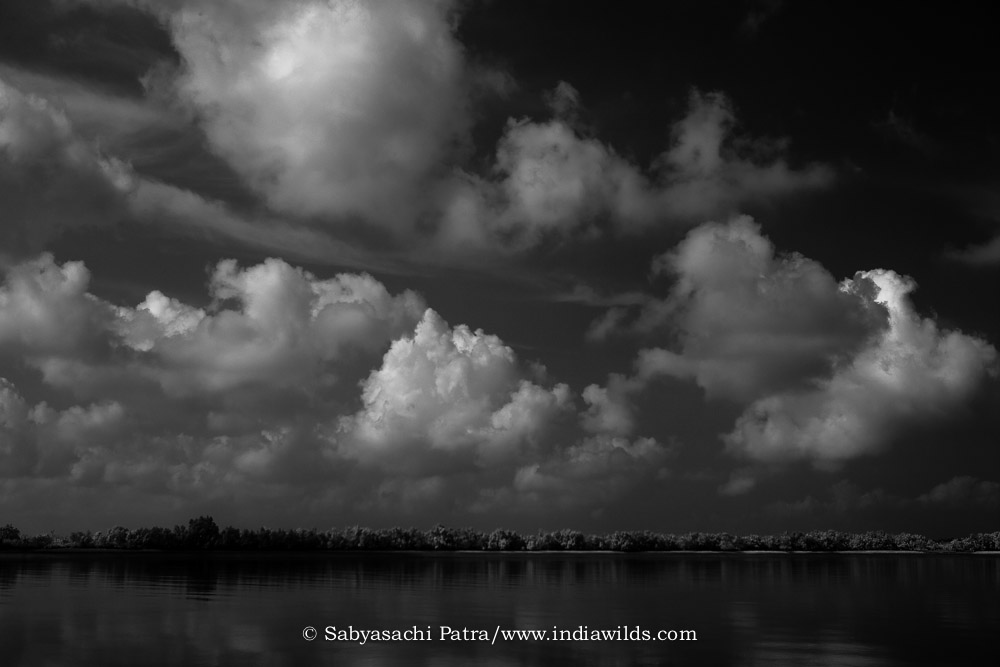





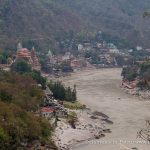







Leave a Reply